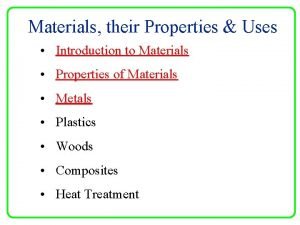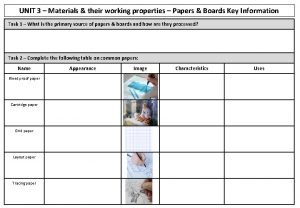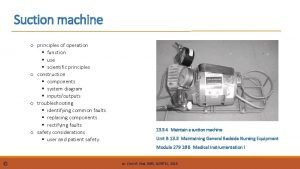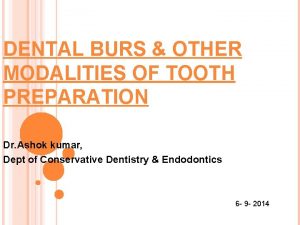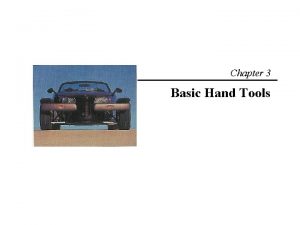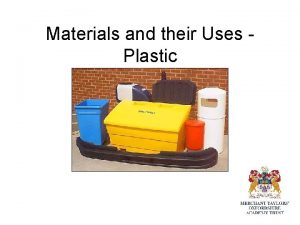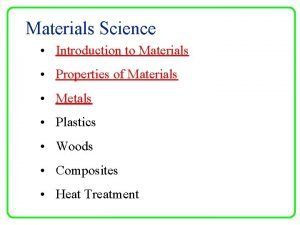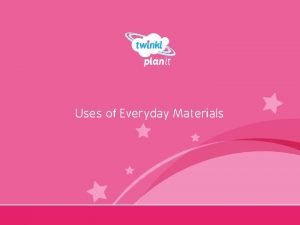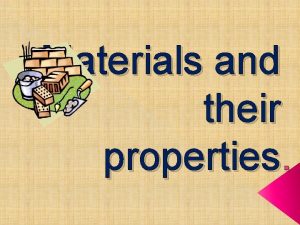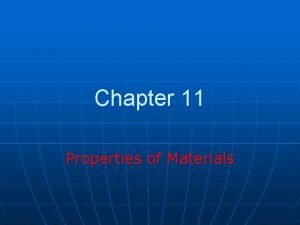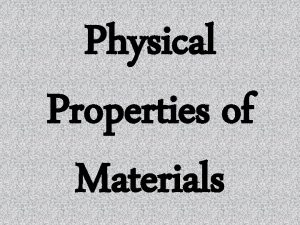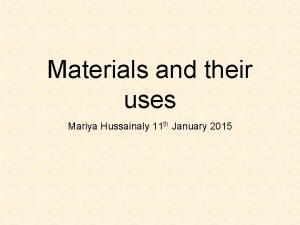Materials their Properties Uses Introduction to Materials Properties
















- Slides: 16

Materials, their Properties & Uses • Introduction to Materials • Properties of Materials • Metals • Plastics • Woods • Composites • Heat Treatment

Introduction to Materials • Materials are used to make or build objects. • During the past 200 years there has been an enormous increase in the range of materials available to us. It is therefore important that the correct materials be used for a particular use. • In Selecting the best material you need to look at 4 things: Physical properties, Cost and Time, Shaping and Forming and Availability.

Selecting the best material – A checklist 1 PHYSICAL PROPERTIES Hardness Tensile Strength Compressive Strength Shear Strength Stiffness Toughness Malleable Corrosive Appearance Weight Conductivity S E L E C T I O N 2 WHAT COST? The materials The extras (fittings etc) 3 SHAPING & FORMING Cutting out Moulding Casting Joining 4 AVAILABILITY Are they easy to obtain including fittings.

Properties of Materials • Each material has many properties. It is incorrect, for example to describe a material as just ‘strong’ or ‘weak’ as for example concrete is strong in compression but weak in tension. Hardness Toughness Strength Brittleness Malleability Ductility Elasticity Plasticity Conductivity Density Fatigue Stiffness

Hardness • The ability of a material to resist wear indentation and scratching. An example of a hardness test that can be carried out in the lab. Different materials are used and the depth of indentation measured

Toughness • The ability of a material to withstand blows or sudden impact. Different materials are used, the hammer is swung from the same height each time about a fixed fulcrum. The distance travelled after impact or fracture is used to find toughness

Strength • The ability of a material to withstand forces of tension, compression and torsion Tensile Strength – the ability to withstand pulling forces or Tension forces Compressive Strength – the ability to withstand ‘squeezing’ forces or Compression forces Torsional Strength – the ability to withstand ‘twisting’ forces or Torsion forces

Brittleness • A material that is easily fractured by impact is said to be brittle e. g. Glass The same as the toughness test however those materials that fracture easily are said to be brittle.

Malleability • A material that can be rolled or hammered into shape without rupture. As ring rises the side of Coke can is thinned out

Ductility • A material that can be pulled or stretched into a thin wire or thread.

Elasticity • The ability of a material to return to its original shape after deformation.

Plasticity • The ability of a material to be permanently deformed without fracture. .

Conductivity • The ability of a material to allow Heat or electricity to flow through it. Ball Bearing drops from most conductive 1 st.

Density • Is the mass of 1 cubic centimetre (cm 3) of a substance. (Mass per unit Volume) Q. Which is heavier a tonne of feathers or a tonne of lead? Q. Which has the greatest density? Density = Mass Volume

Fatigue • Occurs when materials have become overworked and fracture or fail.

Stiffness • The ability of a material to resist bending deformation.
 Classification of hinge
Classification of hinge What is the useful and harmful materials
What is the useful and harmful materials Malleability and ductility
Malleability and ductility Properties of foil lined board
Properties of foil lined board Simple electrical tools
Simple electrical tools Working principle of a suction machine
Working principle of a suction machine Basic body positions nursing
Basic body positions nursing Introduction to surveying ppt
Introduction to surveying ppt Different types of microscope and their uses
Different types of microscope and their uses Cotton rings and hand rolls definition
Cotton rings and hand rolls definition Burs for class 2 cavity preparation
Burs for class 2 cavity preparation Basic hand tools and their uses
Basic hand tools and their uses Describe how to hold a thermal iron
Describe how to hold a thermal iron The three parts of a pin curl are the
The three parts of a pin curl are the Claws of birds and their uses
Claws of birds and their uses Electrical tools and their uses
Electrical tools and their uses Glass stool
Glass stool


